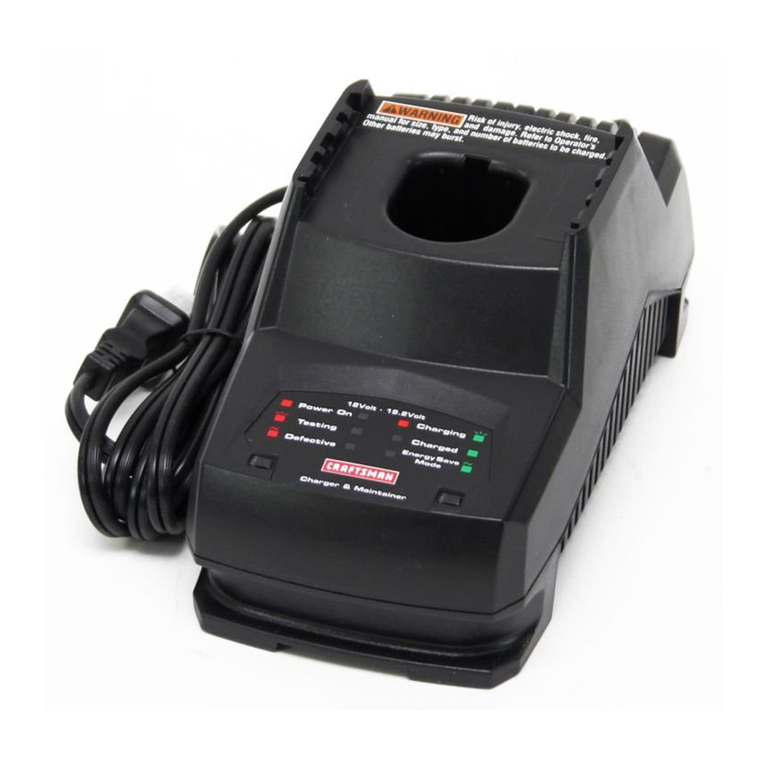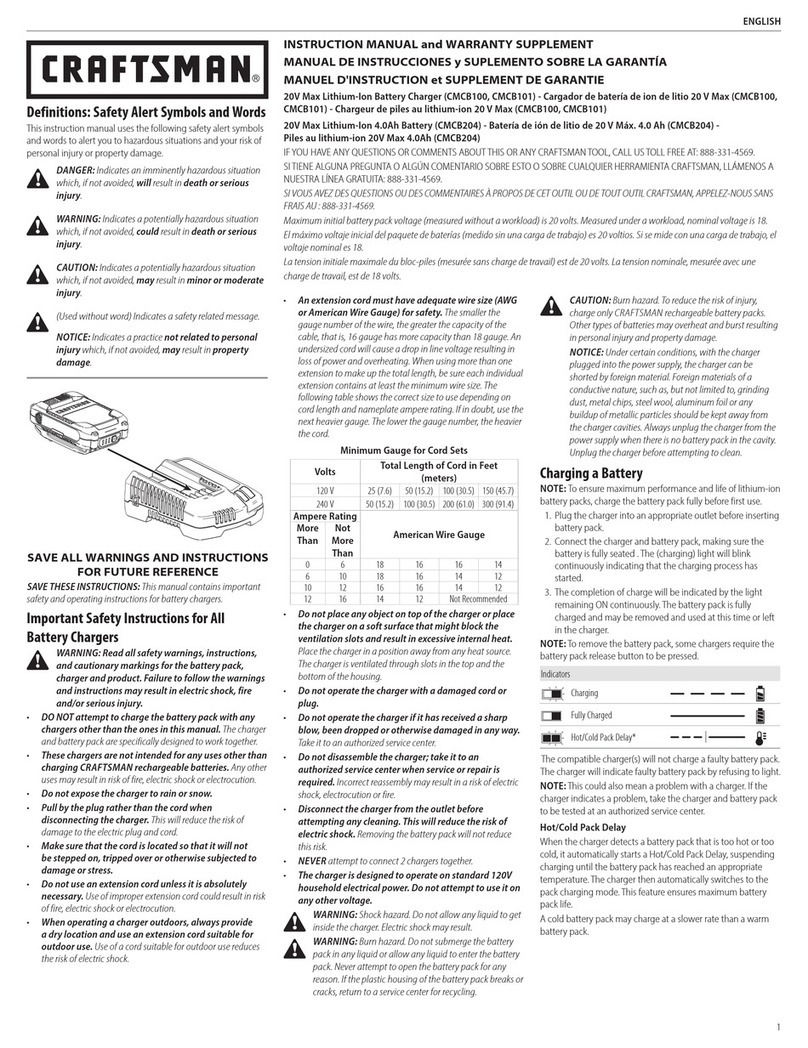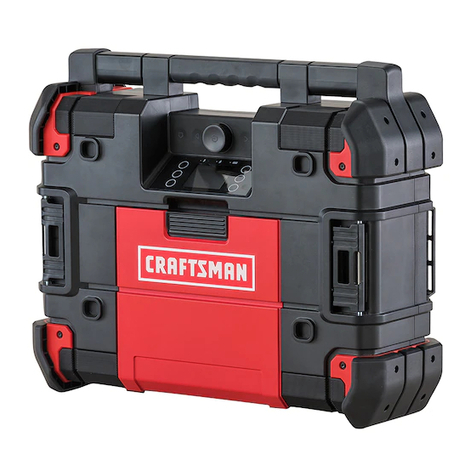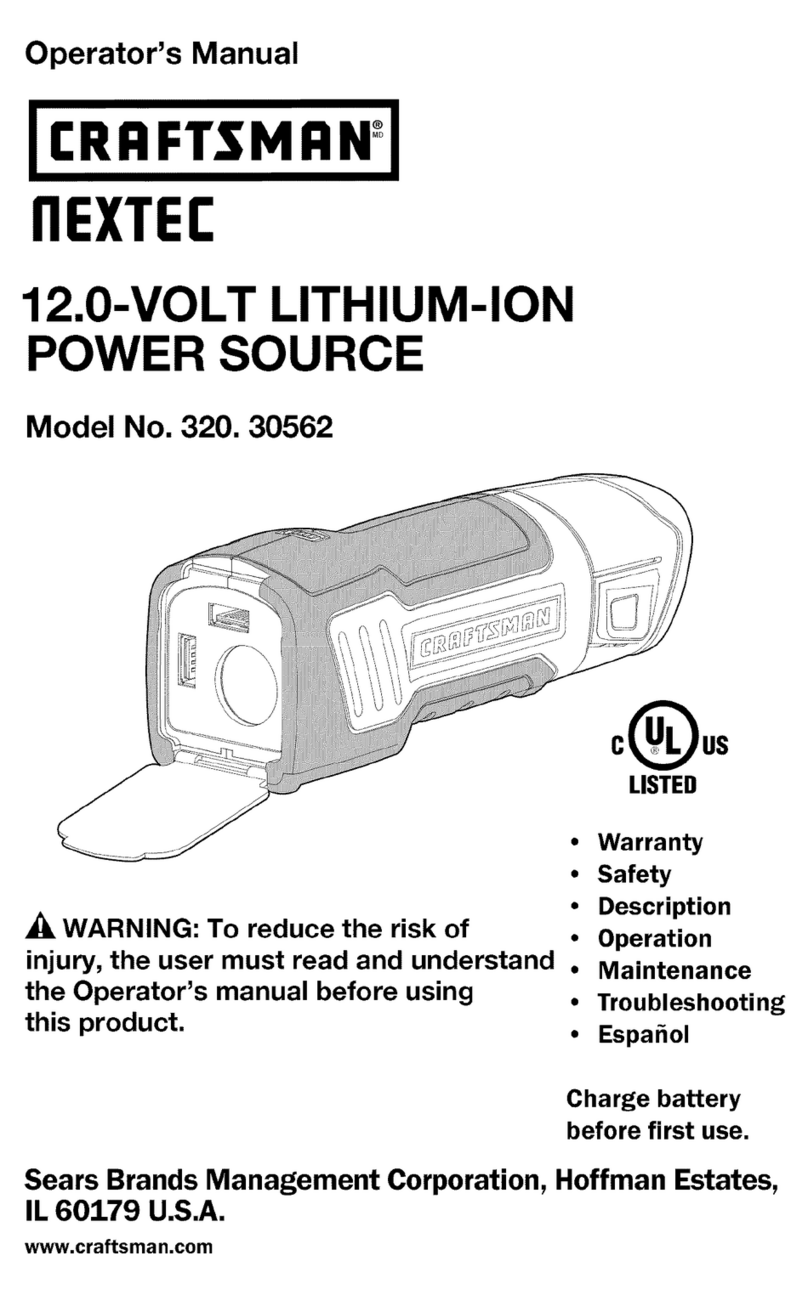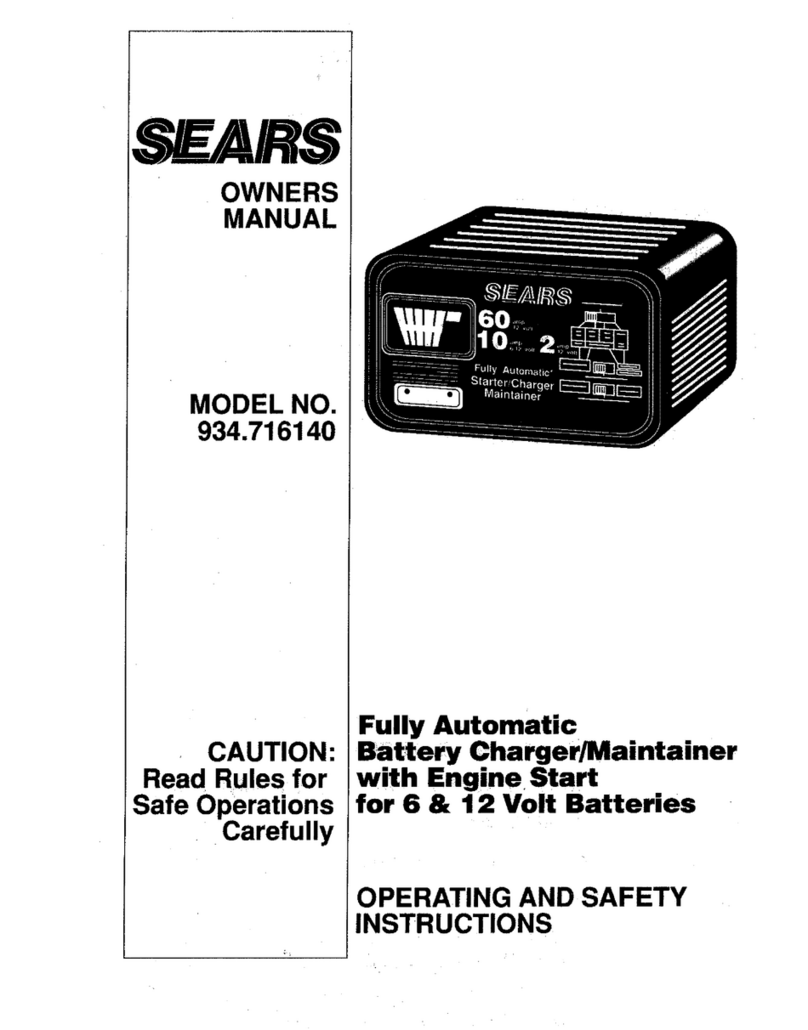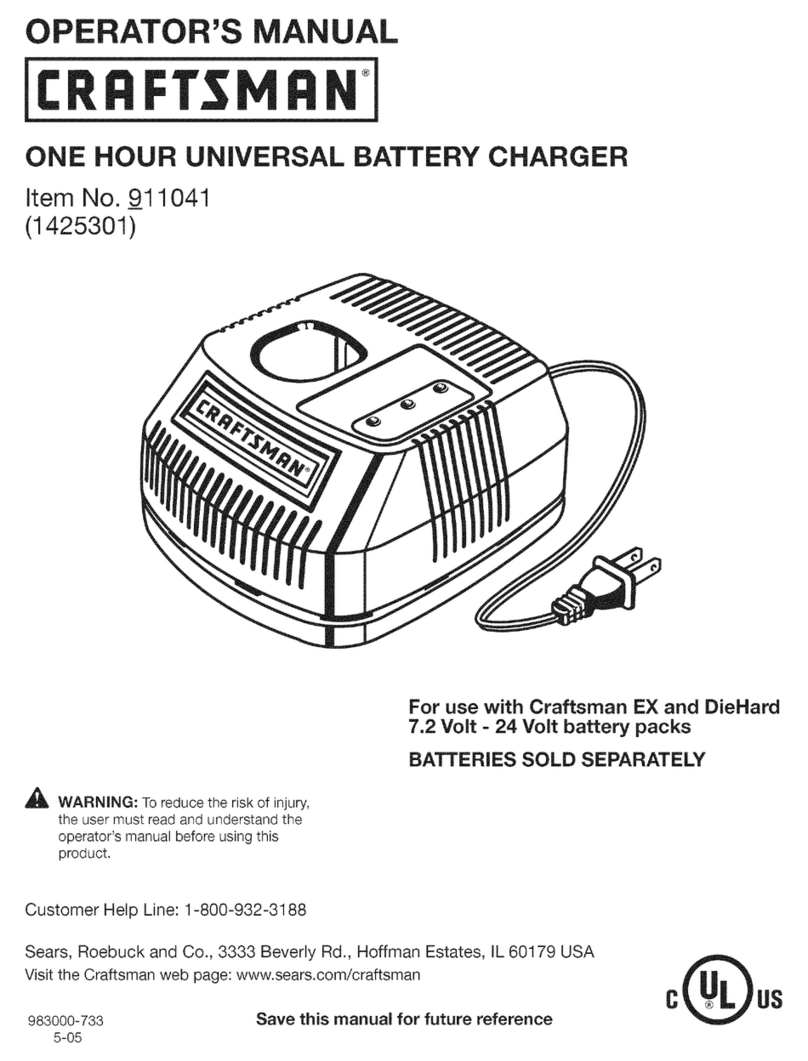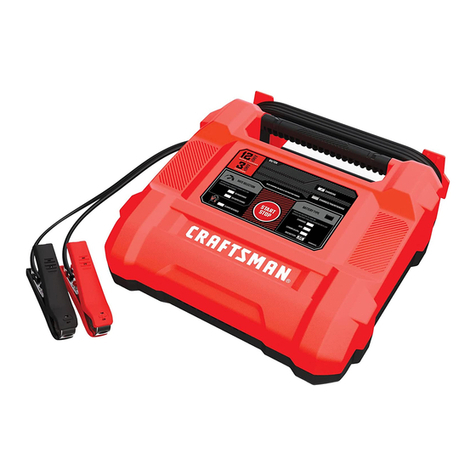
4
ESPAÑOL
Montaje en la pared
Estos cargadores están diseñados para montarse en la pared o
colocarse en posición vertical sobre una mesa o superficie de
trabajo. Si lo monta en la pared, coloque el cargador al alcance
de una toma de corriente eléctrica y alejado de las esquinas u
otras obstrucciones que puedan impedir el flujo de aire. Utilice
la parte de atrás del cargador como plantilla para la ubicación
de los tornillos de montaje en la pared. Monte el cargador
firmemente utilizando tornillos para muro seco (comprados
por separado) de un mínimo de 25,4 mm (1") de largo, con una
cabeza de un diámetro de 7-9 mm (0,28–0,35"), atornillados
en madera hasta una profundidad óptima dejando el tornillo
expuesto aproximadamente 5,5 mm (7/32"). Alinee las ranuras
en la parte trasera del cargador con los tornillos expuestos e
introdúzcalos totalmente en lasranuras.
Los cargadores CRAFTSMAN pueden montarse en la pared con
VersaTrack Trackwall de CRAFTSMAN. Los ganchos y accesorios
se venden por separado. Consulte la hoja de accesorios
VersaTrackTrackwall para obtener más información..
LEA TODAS LAS INSTRUCCIONES
Instrucciones de Seguridad Importantes
Para Todas las Unidades de Batería
ADVERTENCIA: Lea todas las advertencias de
seguridad, instrucciones y marcas de precaución
para el paquete de la batería, el cargador y
el producto. No seguir las advertencias y las
instrucciones puede provocar una descarga
eléctrica, un incendio y/o lesiones graves.
• No cargue o use la unidad de batería en atmósferas
explosivas, como en presencia de líquidos, gases o
polvos inflamables. Puede que al insertar o sacar la unidad
de batería del cargador se inflamen el polvo o losgases.
• NUNCA fuerce la unidad de batería para que entre
en el cargador. NO modifique la unidad de batería
en ninguna forma para que entre en un cargador
no compatible, pues puede producir una ruptura en
la unidad de batería y causar lesiones corporales
graves. Consulte la tabla al final de este manual para ver la
compatibilidad entre baterías ycargadores.
• Cargue las unidades de batería sólo en los cargadores
designados porCRAFTSMAN .
• NO salpique con ni sumerja en agua u otroslíquidos.
• No guarde ni use la herramienta y unidad de batería
en lugares donde la temperatura pueda alcanzar o
superar los 40°C (104 °F), tales como cobertizos o
construcciones de metal durante el verano). Almacene
las unidades de batería en lugares frescos y secos para
maximizar su vidaútil.
NOTA: No almacene las unidades de batería
en la producto con el interruptor de gatillo en
posición encendida fija. Nunca use cinta adhesiva
para mantener el interruptor de gatillo en
posiciónENCENDIDA.
• No incinere la unidad de batería, aunque esté
completamente dañada o descargada. La unidad de
batería puede explotar si se quema. Cuando se queman
unidades de batería de iones de litio, se producen gases y
materialestóxicos.
• Si el contenido de la batería entra en contacto con la
piel, lave el área de inmediato con agua y un jabón
suave. Si el líquido de la batería entra en contacto con sus
ojos, enjuáguelos con agua y los ojos abiertos por 15 minutos
o hasta que cese la irritación. Si se requiere de asistencia
médica, el electrolito de la batería está compuesto por una
mezcla de carbonatos orgánicos líquidos y sales delitio.
• El contenido de los elementos abiertos de la batería
puede causar irritación en el tracto respiratorio.
Salga al aire fresco. Si los síntomas persisten, busque
asistenciamédica.
ADVERTENCIA: Peligro de quemaduras. El líquido de
la batería puede ser inflamable si se expone a chispas
ollamas.
ADVERTENCIA: Peligro de incendio. Nunca intente abrir
la unidad de batería por ningún motivo. Si la caja exterior
de la unidad de batería se triza o daña, no la introduzca
en el cargador. No triture, deje caer o dañe la unidad de
batería. No use una unidad de batería o un cargador que
haya sido golpeado, dejado caer, atropellado o dañado
en cualquier forma (por ejemplo, perforado por un clavo,
golpeado con un martillo, pisado). Lleve sus unidades
de batería dañadas al centro de servicio para que
seanrecicladas..
Recomendaciones de almacenamiento
1. El mejor lugar de almacenamiento es uno que sea fresco y
seco, lejos de la luz solar directa y del exceso de calor o frío.
2. Para resultados óptimos durante tiempos prolongados de
almacenamiento, se recomienda almacenar la unidad de
batería completamente cargada en un lugar fresco y seco
fuera del cargador.
NOTA: Las unidades de batería no deberían almacenarse
completamente descargadas. La unidad de batería deberá
recargarse antes de ser usada.
El sello RBRC®
El sello RBRC® (Rechargeable Battery Recycling
Corporation) en las baterías (ounidades de
batería) de níquel cadmio, níquel e hidruro
metálico o de iones de litio indica que el costo de reciclaje de
estas baterías (o unidades de batería) al llegar al final de su vida
de servicio ya ha sido pagado por CRAFTSMAN. En algunas
áreas, es ilegal depositar baterías de níquel cadmio, níquel e
hidruro metálico o de iones de litio gastadas en la basura o
la corriente de residuos sólidos urbanos; el programa Call 2
Recycle® proporciona una alternativaecológica.
Call 2 Recycle, Inc., en cooperación con CRAFTSMAN y otros
usuarios de baterías, han establecido programas en los Estados
Unidos y Canadá para facilitar la recolección de baterías de
níquel cadmio, níquel e hidruro metálico o de iones de litio
gastadas. Al llevar sus baterías de níquel cadmio, níquel e
hidruro metálico y de iones de litio gastadas a un centro de
servicio autorizado por CRAFTSMAN o al minorista local para
que sean recicladas, ayuda a proteger el medio ambiente y a
conservar recursos naturales. También puede comunicarse con
el centro de reciclaje de su localidad para mayor información
sobre dónde llevar sus bateríasgastadas.
RBRC® es una marca comercial registrada de Call 2 Recycle,Inc.
Transporte
ADVERTENCIA:Peligro de incendio. No guarde
o transporte la batería de forma que los
terminarles expuestos de la misma puedan estar
en contacto con objetos metálicos. Por ejemplo,
no ponga la batería en delantales, bolsillos, cajas de
herramientas, estuches de productos, cajones, etc.,
junto con clavos, tornillos, y llaves, etc. sueltos. El
transporte de baterías puede causar incendios
si sus terminales inadvertidamente entran en
contacto con materiales conductores como llaves,
monedas, herramientas manuales y otros por el
estilo. El Reglamento sobre Materiales Peligrosos (HMR)
del Departamento de Transporte de EE.UU. prohíbe
transportar baterías comercialmente o en aviones en
el equipaje de mano A MENOS que estén debidamente
protegidas contra cortocircuitos. Por lo tanto, cuando
transporte baterías individuales, asegúrese de que sus
terminales estén protegidos y debidamente aislados de
los materiales que pudieran entrar en contacto con ellos y
provocar un cortocircuito.
MANTENIMIENTO
Reparaciones
El cargador y las unidades de batería no pueden serreparados.
El cargador y la unidad de batería no contienen piezas
reparables.
ADVERTENCIA: Para asegurar la SEGURIDAD y la
CONFIABILIDAD del producto, las reparaciones, el
mantenimiento y los ajustes (inclusive la inspección
y el cambio de las escobillas, cuando proceda) deben
ser realizados en un centro de mantenimiento en la
fábrica CRAFTSMAN u en un centro de mantenimiento
autorizado CRAFTSMAN. Utilice siempre piezas de
repuestoidénticas.
Registro en línea
Gracias por su compra. Registre su producto ahorapara:
• SERVICIO EN GARANTÍA: Si completa esta tarjeta, podrá
obtener un servicio en garantía más eficiente, en caso de
que exista un problema con suproducto.
• CONFIRMATCIÓN DE PROPIEDAD: En caso de una
pérdida que cubra el seguro, como un incendio, una
inundacíon o un robo, el registro de propiedad servirá
como comprobante decompra.
• PARA SU SEGURIDAD: Si registra el producto, podremos
comunicarnos con usted en el caso improbable que se
deba enviar una notificación de seguridad conforme a la
Federal Consumer Safety Act (Ley Federal de Seguridad de
Productos para el Consumidor).
Registro en línea en www.craftsman.com/registration.
Garantía limitada por dos años
Craftsman reemplazará, sin cargo, por cualquier defecto debido
a materiales defectuosos o problemas en la mano de obra
de la batería (CMCB201) o el cargador de baterías (CMCB100)
durante dos años a partir de la fecha de la compra. Esta garantía
no cubre falla de partes debido al desgaste normal o abuso de
la herramienta. Para detalles adicionales de la cobertura de la
garantía e información de reparación de garantía, visite www.
craftsman.com o llame al 1-888-331-4569. Esta garantía no
se aplica a accesorios o daño causado cuando otros hayan
realizado o intentado reparaciones. ESTA GARANTÍA LIMITADA
SE OTORGA EN LUGAR DE TODAS LAS DEMÁS, INCLUIDA LA
GARANTÍA IMPLÍCITA DE COMERCIABILIDAD E IDONEIDAD
PARA UN PROPÓSITO EN PARTICULAR, Y EXCLUYE TODOS LOS
DAÑOS INCIDENTALES O EN CONSECUENCIA. Algunos estados
no permiten limitaciones sobre la duración de una garantía
implícita o la exclusión o limitación de daños incidentales
o en consecuencia, por lo que estas limitaciones pueden
no aplicarse en su caso. Esta garantía le da derechos legales
específicos y puede tener otros derechos que varían en ciertos
estados o provincias..
NOTA: La garantía del producto quedará nula si la unidad de
batería ha sido alterada de cualquier manera. CRAFTSMAN no
es responsable de ninguna lesión causada por alteraciones y
podría iniciar un procedimiento judicial por fraude de garantía
hasta el máximo grado permisible por laley.
AMÉRICA LATINA: Esta garantía no se aplica a los productos
que se venden en América Latina. Para los productos que
se venden en América Latina, debe consultar la información
de la garantía específica del país que viene en el empaque,
llamar a la compañía local o visitar el sitio Web a fin de obtener
esainformación.
CRAFTSMAN® is a registered trademark of Stanley Black & Decker, Inc., used under license.
CRAFTSMAN® es una marca registrada de Stanley Black & Decker, Inc., utilizada bajo licencia.
© 2018 CRAFTSMAN U.S. & Canada Only
CRAFTSMAN.com
Form No. 769-19570A
(December 13, 2018)

